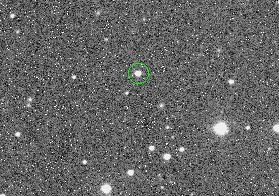(69230) Hermes
|
Asteroid (69230) Hermes |
|
|---|---|

|
|
| Properties of the orbit ( animation ) | |
| Orbit type | Apollo type |
| Major semi-axis | 1,655 AU |
| eccentricity | 0.624 |
| Perihelion - aphelion | 0.623 AU - 2.688 AU |
| Inclination of the orbit plane | 6.067 ° |
| Sidereal period | 2 a 47 d |
| Mean orbital velocity | 23.15 km / s |
| Physical Properties | |
| Medium diameter | 2 × 300 m - 450 m |
| Dimensions | ? kg |
| Albedo | 0.13 |
| Medium density | ? g / cm³ |
| Rotation period | 13 h 54 m |
| Absolute brightness | 17.5 likes |
| Spectral class | S type |
| history | |
| Explorer | Karl Wilhelm Reinmuth |
| Date of discovery | October 28, 1937 |
| Another name | 1937 UB |
| Source: Unless otherwise stated, the data comes from JPL Small-Body Database Browser . The affiliation to an asteroid family is automatically determined from the AstDyS-2 database . Please also note the note on asteroid items. | |
(69230) Hermes is a near-Earth asteroid belonging to the Apollo type. It was discovered by Karl Wilhelm Reinmuth on October 28, 1937 , when the asteroid flew 1.5 times the lunar distance past the Earth, its diameter was estimated at 1200 m. After five days it was lost again. The heavenly body was named after the Roman messenger of the gods Hermes . Since its orbit could not be determined due to the short observation period, it was initially not given an official number, which is usually placed in front of the asteroid names.
In October 2003 the minor planet was found and identified with LONEOS , one of the ten modern search projects. It was given the number 69230. This time Hermes passed the earth 10 times further away (on November 4th, 2003 in 7 million km). An exact determination of the orbit showed that Hermes had approached the earth unobserved up to 1.6 times the lunar distance.
Orbits that come close to Mars or Venus can probably also be close to the earth. The former has been called the Cupid type since 1932 , although such bodies with (433) Eros were discovered in 1898 by Georg Witt and (719) Albert in 1911 by Johann Palisa . The latter asteroid, however, was lost and was not rediscovered until 2000 by the Spacewatch team. Other objects with orbits close to the earth are asteroids of the Apollo-type and Aten-type .
According to radar observations, Hermes is a double asteroid with a moon of the same size. Photometric observations have shown that the two components orbit each other in 13.892 hours, always facing the same side.
See also
swell
- ↑ International Astronomical Union Circular No. 8227
- ↑ International Astronomical Union Circular No. 8233
Web links
- (69230) Hermes in the Small-Body Database of the Jet Propulsion Laboratory (English).
- The Curious Tale of Asteroid Hermes (English)